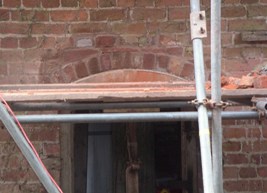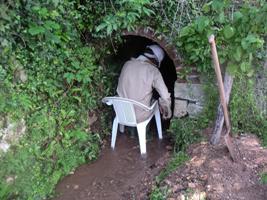Turning a Millstone
15th May 2007

It was a select team on site today, Martyn, Colin, Headley, Derek and Richard. It wasn’t the threat of rain that was putting people off, but other commitments. In fact the weather was kind to us, with only a couple of showers and quite a lot of sunny spells. At lunchtime the sun was almost too hot and one of the showers led to the experiment with the millstone.
Martyn set about laying the brick arch that he had done all the preparation for last week and made a nice job of it as you can see from the photograph. He then chased out some mortar courses ready to have HeliBar inserted. We are assured that these shaped stainless steel rods will stop the cracked brickwork from parting any further so we are going to give them a try.
Derek carried on with his heavy duty gardening, trimming laurel bushes back that were threatening to tangle with the overhead power cables supplying the Court House. As well as preventing power problems this has opened up the view of the church from the house.
Colin and Headley spent a short time working on the waterwheel, but they have run out of new plates to fit. They moved just inside the mill and started to clean up the pit gear. This bevel gear is made from cast iron in two halves, bolted together round the main shaft. Apart from surface rust and some dried mud this gear is in excellent condition without any apparent cracks and with all its teeth intact.

Most unusually, Richard did not mix any mortar today. Martyn had to mix his own to set the brick arch. This was because Richard had dreamt up an easy way of dredging out the culvert and lowering the water level in the waterwheel pit. Easy is a relative term in this case, as it was still hard work. The secret was to sit down on the job. The culvert is under five feet high and any digging has to be done bent over. As you can see from the picture a garden chair is just the right height, giving a couple of inches clearance between hard hat and hard bricks. So, walk up the culvert dragging the chair. Sit down, shovel mud and gravel towards chair. Move chair back a foot or so and repeat. When the end of the culvert is reached shovel the spoil onto the bank. Repeating the whole process several times lowered the water level by about three inches. The waterwheel is still standing in water, but every inch we can lower the standing water will increase the amount of power we can put to a millstone or two.
Go to the next entry by clicking here.
Read about the millstone? Click here to see the previous article.
Leave the Shelsey Mill Blog and return Home.